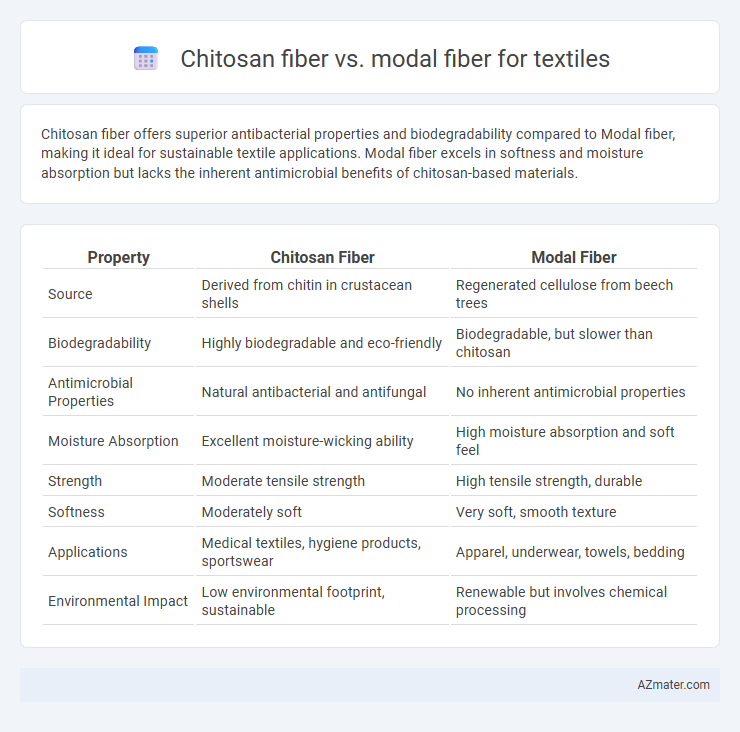Chitosan fiber offers superior antibacterial properties and biodegradability compared to Modal fiber, making it ideal for sustainable textile applications. Modal fiber excels in softness and moisture absorption but lacks the inherent antimicrobial benefits of chitosan-based materials.
Table of Comparison
| Property | Chitosan Fiber | Modal Fiber |
|---|---|---|
| Source | Derived from chitin in crustacean shells | Regenerated cellulose from beech trees |
| Biodegradability | Highly biodegradable and eco-friendly | Biodegradable, but slower than chitosan |
| Antimicrobial Properties | Natural antibacterial and antifungal | No inherent antimicrobial properties |
| Moisture Absorption | Excellent moisture-wicking ability | High moisture absorption and soft feel |
| Strength | Moderate tensile strength | High tensile strength, durable |
| Softness | Moderately soft | Very soft, smooth texture |
| Applications | Medical textiles, hygiene products, sportswear | Apparel, underwear, towels, bedding |
| Environmental Impact | Low environmental footprint, sustainable | Renewable but involves chemical processing |
Introduction to Chitosan and Modal Fibers
Chitosan fiber, derived from chitin found in crustacean shells, offers excellent biodegradability and antibacterial properties, making it a sustainable choice for textile applications. Modal fiber, a type of rayon made from beech tree pulp, is known for its softness, breathability, and durability, often used in high-end garments and home textiles. Both fibers provide eco-friendly alternatives, with chitosan focusing on antimicrobial benefits and modal emphasizing comfort and moisture management.
Origins and Production Processes
Chitosan fiber is derived from chitin, a natural polysaccharide extracted from crustacean shells through deacetylation, while Modal fiber is made from regenerated cellulose sourced from beechwood pulp using a chemical-intensive spinning process. Chitosan fiber production involves biopolymer extraction and blending with other fibers to enhance antimicrobial and biodegradable properties. Modal fiber manufacturing requires dissolving cellulose in chemicals like sodium hydroxide and carbon disulfide, followed by extrusion and regeneration, producing a soft, breathable textile with high moisture absorption.
Chemical Structure and Composition
Chitosan fiber is derived from chitin, primarily composed of b-(1-4)-linked D-glucosamine units, exhibiting unique biopolymer characteristics such as biodegradability and antimicrobial properties. Modal fiber, a regenerated cellulose fiber, consists mainly of cellulose with b-(1-4)-linked D-glucose units, providing high moisture absorption and strength. The chemical structure of chitosan introduces amino groups, enhancing functionality in textiles, whereas modal's polysaccharide composition favors softness and breathability.
Environmental Impact and Sustainability
Chitosan fiber, derived from chitin found in crustacean shells, offers remarkable biodegradability and antimicrobial properties, making it highly sustainable compared to modal fiber, which is produced from chemically processed beechwood pulp. The production of chitosan fiber involves less water and energy consumption, significantly reducing environmental pollution and carbon footprint. Modal fiber, while semi-biodegradable and recyclable, often requires intensive chemical treatments and large amounts of water, raising concerns about its overall ecological footprint in textile manufacturing.
Physical Properties and Performance
Chitosan fiber exhibits superior antimicrobial properties and enhanced moisture absorption compared to Modal fiber, making it ideal for hygienic and activewear textiles. Modal fiber boasts excellent softness, high tensile strength, and better color retention, which improves fabric durability and comfort. Both fibers offer good breathability, but Chitosan's bioactive nature provides additional odor control and skin-friendly benefits not present in Modal.
Comfort and Wearability in Textiles
Chitosan fiber offers superior moisture absorption and antibacterial properties, enhancing comfort and reducing odor in textiles compared to Modal fiber. Modal fiber provides excellent softness and breathability, improving wearability with a smooth touch and good moisture management. Both fibers contribute to comfort, but Chitosan's bioactive features deliver additional health benefits that Modal fibers lack.
Biodegradability and Eco-friendliness
Chitosan fiber, derived from natural chitin in crustacean shells, exhibits superior biodegradability compared to modal fiber, which is a semi-synthetic cellulose-based fiber. The biodegradation process of chitosan fiber occurs rapidly in soil and marine environments, minimizing environmental impact, while modal fiber, although biodegradable, decomposes more slowly due to chemical processing. Chitosan fiber's natural antimicrobial properties also enhance its eco-friendliness by reducing the need for chemical treatments in textile production.
Antimicrobial and Functional Benefits
Chitosan fiber exhibits superior antimicrobial properties due to its natural biopolymer structure that inhibits bacterial growth and enhances odor resistance, making it highly suitable for hygienic textile applications. Modal fiber, derived from beech tree cellulose, offers excellent moisture absorption and softness but lacks inherent antimicrobial functionality. Combining chitosan fiber with modal can produce textiles that maximize comfort and durability while providing effective antimicrobial protection.
Applications in Modern Textiles
Chitosan fiber, derived from chitin in crustacean shells, offers antimicrobial properties and biodegradability, making it ideal for medical textiles, sportswear, and hygienic fabrics. Modal fiber, a semi-synthetic cellulose fiber from beech trees, excels in softness, breathability, and moisture absorption, widely used in luxury apparel, activewear, and home textiles. Both fibers enhance performance and sustainability, with chitosan providing functional benefits and modal emphasizing comfort and eco-friendly production.
Comparative Analysis and Future Trends
Chitosan fiber exhibits superior antibacterial properties and biodegradability compared to Modal fiber, making it increasingly favored in sustainable textile applications. Modal fiber, derived from beech trees, offers excellent softness and moisture-wicking qualities but lacks the natural antimicrobial benefits inherent to Chitosan fiber. Future trends indicate growing investment in chitosan-based textiles due to rising consumer demand for eco-friendly, functional fabrics that combine comfort with health benefits.

Infographic: Chitosan fiber vs Modal fiber for Textile
 azmater.com
azmater.com